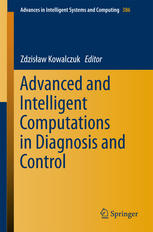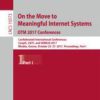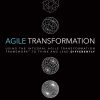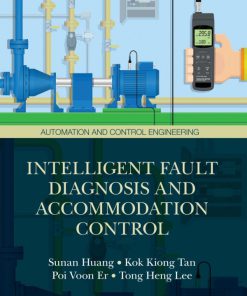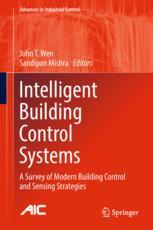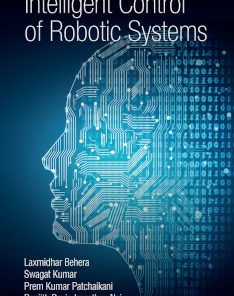Advanced and Intelligent Computations in Diagnosis and Control 1st Edition by Zdzisław Kowalczuk ISBN 3319231804 9783319231808
$50.00 Original price was: $50.00.$25.00Current price is: $25.00.
Advanced and Intelligent Computations in Diagnosis and Control 1st Edition by Zdzisław Kowalczuk – Ebook PDF Instant Download/Delivery: 3319231804, 9783319231808
Full download Advanced and Intelligent Computations in Diagnosis and Control 1st Edition after payment
Product details:
ISBN 10: 3319231804
ISBN 13: 9783319231808
Author: Zdzisław Kowalczuk
This book is devoted to the demands of research and industrial centers for diagnostics, monitoring and decision making systems that result from the increasing complexity of automation and systems, the need to ensure the highest level of reliability and safety, and continuing research and the development of innovative approaches to fault diagnosis. The contributions combine domains of engineering knowledge for diagnosis, including detection, isolation, localization, identification, reconfiguration and fault-tolerant control. The book is divided into six parts: (I) Fault Detection and Isolation; (II) Estimation and Identification; (III) Robust and Fault Tolerant Control; (IV) Industrial and Medical Diagnostics; (V) Artificial Intelligence; (VI) Expert and Computer Systems.
Advanced and Intelligent Computations in Diagnosis and Control 1st Table of contents:
Part I Fault Detection and Isolation
Fault Diagnosis Based on Controller Modification
1 Introduction
2 The YJBK Architecture
2.1 The YJBK Parameterization
2.2 Closed-Loop System
3 Active Fault Diagnosis
3.1 Controller Based Detection
4 Fault Detection
5 Fault Isolation
5.1 Passive Based Isolation
5.2 Active Based Isolation
6 Discussion
References
One Approach to Design the Fuzzy Fault Detection Filters for Takagi-Sugeno Models
1 Introduction
2 Takagi-Sugeno Fuzzy Fault Detection Filter
3 Reference Residual Model
4 FDF Design Condition
5 Illustrative Example
6 Concluding Remarks
References
Robust UIO Design for an Actuator Fault Identification
1 Introduction
2 Methodology of the Robust UIO Design for the Actuators Faults Estimation
3 Fault Identification of the Multi-tank System
4 Conclusions
References
Design of an Adaptive Sensor and Actuator Fault Estimation Scheme with a Quadratic Boundedness Appro
1 Introduction
2 Fault Estimation Strategy
3 Adaptive Threshold Design
4 Case Study
5 Conclusions
References
Single Fault Isolability Metrics of the Binary Isolating Structures
1 Introduction
1.1 Theoretical Diagnosis Accuracy
1.2 Conditional and Unconditional Fault Distinguishability
1.3 The Measure of Fault Isolability
2 Redefinition of Single Fault Isolability Metrics
2.1 The Isolability Degree
2.2 Mean Isolability Metrics
2.3 Normalized Drastic Isolability Metric
2.4 The Practical Example
3 Summary
References
Optimal Sensor Placement Under Budgetary Constraints
1 Introduction
2 Theoretical Background
2.1 Binary Diagnostic Matrix
2.2 The Measure of Fault Isolability of Diagnostic System for Binary Diagnostic Matrix
3 Problem Formulation
4 Solving Problem with Branch-and-Bound Algorithm
5 Fuel Cell Stack System
6 Conclusion
References
Part II Estimation and Identification
Discrete-Time Estimation of Nonlinear Continuous-Time Stochastic Systems
1 Introduction
2 System Model
3 Model Discretization
4 State Estimation
4.1 Unscented Kalman Filter
5 Simulation Example
5.1 Process Model
5.2 Estimation Results
6 Conclusions
References
8 Identification of Models and Signals Robust to Occasional Outliers
Abstract
1 Introduction
2 LS and LA Estimation Algorithms
3 Estimation Methods in Numerical Experiments
3.1 Linear Regression
3.2 Approximation of the Spectral Density Function
3.3 Tracking the Frequencies of Multi-Harmonic Signals
4 Conclusions and Further Investigations
References
Adaptive Actuator Fault Estimation for DC Servo Motor
1 Introduction
2 Preliminaries
3 Observer Design
4 Illustrative Example
5 Conclusions
References
Evaluating the Position of a Mobile Robot Using Accelerometer Data
1 Introduction
2 Accelerometer Features
2.1 Nonlinearities and Noise
2.2 DC and Rotation
2.3 Accelerometer Model
3 Robot Model and its State Observers
4 Experiments
4.1 Luenberger Observer
4.2 Kalman Filter
4.3 Sensitivity Study
5 Conculsions
References
Decentralized Scheduling of Sensor Networks for Parameter Estimation of Spatio-Temporal Processes
1 Introduction
2 Optimal Scheduling Problem
3 Decentralized Multi-exchange Algorithm
4 Simulation Example
5 Conclusions
References
Part III Robust and Fault Tolerant Control
MPC Framework for System Reliability Optimization
1 Introduction
2 Reliability Modelling
2.1 Bayesian Network Framework
2.2 System Reliability
2.3 Importance Factors
2.4 Component Reliability
3 Reliability-Aware MPC
3.1 MPC Formulation
3.2 Enhancing MPC with Reliability Information
4 Case Study: Drinking Water Network
4.1 DWN Description
4.2 System Reliability Using a Dynamic Bayesian Network Model
5 Results
6 Conclusions
References
Towards Robust Predictive Control for Non-linear Discrete Time System
1 Introduction
2 Preliminaries
3 Design of the State Feedback Controller
4 Efficient Predictive Control
5 Conclusions
References
Self-healing Control Against Actuator Stuck Failures Under Constraints: Application to Unmanned Hel
1 Introduction
2 Problem Statement
3 Main Results
3.1 Fault-Tolerant Control Method
3.2 Self-healing Management
3.3 Reference Redesign
4 Application to Unmanned Helicopters
4.1 Unmanned Helicopter Model
4.2 Simulation Results
5 Conclusions
References
Hinfty Approach to Virtual Actuators Design
1 Introduction
2 Basic Preliminaries
3 Virtual Actuator
4 PI Virtual Actuator
5 Illustrative Example
6 Concluding Remarks
References
Design of a Predictive Fault-Tolerant Control for the Battery Assembly Station
1 Introduction
2 Preliminaries
2.1 Max-plus Algebra and Max-plus Linear Systems
3 Battery Assembly Station
3.1 Max-plus Linear Model
3.2 Handling Constraints
4 Constrained Model Predictive Control
5 Fault-Tolerant Control of the Battery Assembly Station
6 Illustrative Example
7 Conclusions
References
Part IV Industrial and Medical Diagnostics
Approximate Models and Parameter Analysis of the Flow Process in Transmission Pipelines
1 Introduction
2 State Space Model
3 Model Parameterization
4 Analytic Model from Diagonal Approximation
4.1 Approximate Model Derivation with Applicability Conditions
4.2 Model Analysis
5 Summary
References
18 Leak Detection in Liquid Transmission Pipelines During Transient State Related to a Change of Ope
Abstract
1 Introduction
2 Experimental Data Acquired from the Model Pipeline
2.1 The Pilot Pipeline Installation
2.2 Conditions of Experiments
3 Leak Detection Procedures and Results of their Implementation
3.1 Leakage Detection
3.2 Leakage Localization
3.3 Other Potential Applications of Elaborated Procedures
4 Conclusion
Acknowledgment
References
Accuracy Investigations of Turbine Blading Neural Models Applied to Thermal and Flow Diagnostics
1 Introduction
2 Modeling of the Flow
3 Results
4 Conclusions
References
20 Proposition of Electromyographic Signal Interpretation in the Rehabilitation Process of Patients
Abstract
1 Introduction
2 Basic Notions—Fuzzy Sugeno Integral
2.1 Fuzzy Sets
2.2 Fuzzy Sugeno Integral
2.3 Fuzzy Sugeno Integral—Interval based Interpretation
3 The sEMG Signal Interpretation
3.1 The sEMG Interpretation in the Rehabilitation Process
3.2 sEMG Interpretation based on the Fuzzy Sugeno Integral
4 Experiments
5 Conclusion
Acknowledgment
References
Hybrid Classification of High-Dimensional Biomedical Tumour Datasets
1 Introduction
2 Problem Statement and Related Works
3 Multiple Classification Methods
3.1 Classifier Combination Rules
3.2 Bagging and Boosting
3.3 Hybrid Classification
4 Experimental Results
5 Conclusions
References
Part V Artificial Intelligence
Learning and Memory Processes in Autonomous Agents Using an Intelligent System of Decision-Making
1 Introduction
2 Coding Methods in Cognitive Perception
2.1 Syntax of Memorized Objects
3 Knowledge Representation in ISD
3.1 Path of Information
3.2 Discoveries and Their Tecognition
4 Autistic Thinking and Learning
4.1 Process of Restructuring the Memory
5 Conclusions
References
23 Solving Highly-Dimensional Multi-Objective Optimization Problems by Means of Genetic Gender
Abstract
1 Introduction
2 Evolutionary Multi-Objective Optimization
3 The Genetic Gender Approach
3.1 Concept of Genetic Gender
3.2 Concept of the Hierarchical Genetic Gender
4 Synthesis of a Diagnostic State-Observer
4.1 Design of Residue Generators
4.2 Results of Evolutionary Optimization
5 Conclusions
References
24 Experimental Comparison of Straight Lines and Polynomial Interpolation Modeling Methods in Ship E
Abstract
1 Introduction
2 Evolutionary Ship Trajectory Planning
3 Trajectory Modeling
4 Simulations
5 Results and Conclusions
References
Robust Fault Detection by Means of Echo State Neural Network
1 Introduction
2 Echo State Network
3 Model Error Modelling
4 Two Rotor Aero-Dynamical System
5 Experiments
5.1 Neural Modelling
5.2 Fault Detection
6 Conclusion
References
Part VI Expert and Computer Systems
Towards Knowledge Compilation for Automated Diagnosis: A Qualitative, Model-Based Approach with Con
1 Introduction
2 Model-Based Diagnosis: State-of-the-Art
3 Qualitative Approach to Knowledge Compilation
3.1 Qualitative Diagnostic Approach
4 Example
5 More Complex Example
6 Towards Knowledge Compilation
7 Conclusions and Further Work
References
Development of Expert System Shell with Context-Based Reasoning
1 Introduction
2 Context Definition
3 System Requirements and Assumptions
4 Major Functionalities of the Proposed Expert System Shell
5 Dictionary of Statements and Contexts
6 Case Study
7 Summary
References
Fault Detection Method Using Context-Based Approach
1 Introduction
2 Context in Machine Learning
3 Method of Fault Detection Using Context
3.1 Used Classifiers
4 Verification Studies
4.1 Benchmark Problem
4.2 Data Preprocessing and Feature Selection
4.3 Classification Schemes Implementation
4.4 Context Based Approach
4.5 Results of Verification Studies
5 Conclusions
5.1 Future Work
References
Automatic Graph-Based Local Edge Detection
1 Introduction
2 Basic Theory of Graphs, Flow Networks and Graph-Cuts
2.1 Maximum Flow Problem
2.2 Graph Construction
3 Segmentation Based on Flow Network
4 The Proposed Edge Detection Method Based on a Local Approach to Graph Representation of the Image
4.1 Graph Construction
5 Tests
5.1 Experiments on Basic Patterns
5.2 Artificial Example
6 Experimental Results
7 Conclusions
References
30 Harmony Search to Self-Configuration of Fault-Tolerant Grids for Big Data
Abstract
1 Introduction
2 Harmony Search Algorithms
3 Parallel Processing of Big Data
4 Intelligent Agents in Fault-Tolerant Grids
5 Map-Reduce Model for Fault-Tolerant Grid
6 Agents Based on Harmony Search for Reconfiguration
7 Deadlines for Tasks in a New Grid Configuration
8 Concluding Remarks and Future Work
People also search for Advanced and Intelligent Computations in Diagnosis and Control 1st:
advanced and intelligent computations in diagnosis
advanced assessment interpreting findings and formulating differential diagnoses
advanced intelligent systems impact factor
advanced diagnostic imaging cpt codes
difference between intelligence and adaptive behavior
Tags:
Zdzisław Kowalczuk,Advanced,Intelligent Computations,Diagnosis,Control
You may also like…
Computers - Hardware
Mathematics - Optimal control
Intelligent Control of Robotic Systems 1st Edition Laxmidhar Behera


